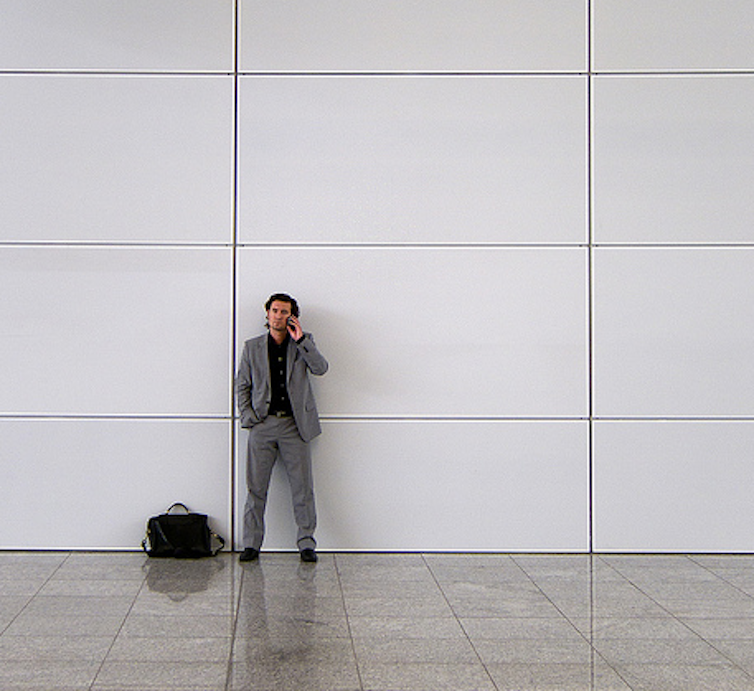Many economic and social commentators, including the University of Canberra’s Josh Fear on The Conversation yesterday, continue to express concern about the number of hours many Australians spend doing paid and unpaid work.
In recent times such concerns have been heightened by the role that new technology is increasingly playing in blurring the boundaries between work and non-work spheres.
But what does the evidence really show?
Overall hours are declining
Despite no notable changes in standard hours since the late 1970s, average working hours in Australia (as reported by workers) have continued to decline, and today stand at less than 34 hours per week.
Most of this decline, however, is due to the rising share of part-time employment, which accounts for almost 30% of all workers (compared with around 10% in 1970).
If we restrict our attention to just full-time workers (those people reporting working 35 hours or more per week) then it is true that the long-term decline in average working hours reversed in the 1980s and early 1990s.
This reversal in the downward trend, however, appears to be contained to the period between 1983 and 1994. Average weekly hours worked by persons in full-time employment is notably less today (41 hours) than it was a decade ago (about 43 hours).
A lot of work for very few
But what about those many Australians who regularly work what could be described as an unreasonable number of hours each week?
A feature of the Australian labour market that it shares with only a few other economies (New Zealand and the UK for example) is the co-existence of both a large part-time employment share and large fraction of “long-hours workers”.
The definition of a long hours worker is anyone who usually reports working 50 or more hours per week, and on this definition some 16% of Australian workers are long hours workers. But again this fraction has been declining – in 2001 it was closer to 19%.
Global comparison

It is also often claimed that the proportion of Australians who work these very long hours is much higher than in most other countries in the industrial world.
Such claims, however, are very wide of the mark and are usually based on data that are not comparable and are Euro-centric.
Using OECD data from before the Global Financial Crisis, and taking care to ensure that data sources are at least roughly comparable, it is very clear that among OECD nations, Korean and Japanese workers spend much more time at work than Australians do.
In Korea, close to 40% of all men and over 30% of all women report usually working 54 hours or more per week. Japan is not far behind.
In Australia, the comparable figures, but using the lower 50 hours cut-off, are 25% and 7%. While no comparable data are available, it’s likely this tendency towards very long work weeks would also be found in most of East Asia, including our most important trading partner, China.
Further, the incidence of long hours working in Australia is not that much different to that recorded in the USA, the UK or New Zealand. It is only when compared with Western and Northern continental Europe that Australian figures seem high.
So yes, many Australians do work very long hours, but this is not especially distinctive, either relative to our past history or to other countries.
The myth of unpaid work
Another myth that is frequently pedaled, and which Fear mentions in his article, is that much work time is unpaid.
This is based on the observation that many Australians, if they were to work one more hour each week would see no change in their fortnightly pay packet.
All salaried workers are in this category, but this can also describe the situation facing other wage earners. Nevertheless, the reality is that every hour worked is paid for; it is just that the true hourly rate is less than the standard weekly wage divided by the “agreed” usual weekly hours.
Moreover, for many of these workers putting in “extra hours”, remuneration comes in other forms, including enhanced promotion and employment prospects.
Is work really intruding on our home lives?

Finally, there is the question of whether or not the changing nature of technology is increasing workers’ “polluted time” (to use the loaded phrase coined by The Australia Institute), with adverse consequences for health, well-being and family functioning.
This is a question that has not been much studied and hence it is difficult to make any definitive assessment. But here are a few observations.
First, such developments will mean measuring working time becomes a lot more difficult. In particular, we might expect worker reports of hours worked to be overstated through the increasing inclusion of non-work activities that are difficult to separate from work time.
Second, this trend is not new. Information and communication technology has long been making it more feasible for work time to encroach on non-work life, yet reported hours of working time are declining.
Third, the interaction runs both ways; thanks to technology and changing types of work organization it is now much more possible for non-work activities to be conducted within work time.
Finally, much of the demand for this new technology appears to be coming from workers themselves, especially the younger generation. Surely such demand reflects a belief that the technology will enhance their lives rather than harm them?

